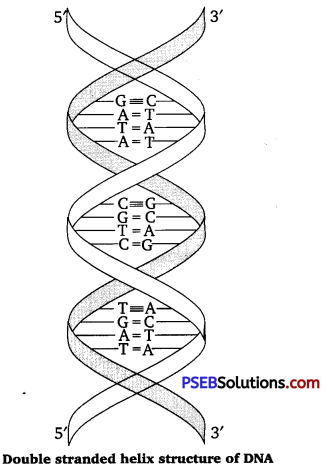Punjab State Board PSEB 12th Class Chemistry Important Questions Chapter 14 Biomolecules Important Questions and Answers.
PSEB 12th Class Physics Important Questions Chapter 14 Biomolecules
Very short answer type questions
Question 1.
What are oligosaccharides?
Answer:
Carbohydrates which on hydrolysis give two to ten molecules of monosaccharides are called oligosaccharides e. g., sucrose.
Question 2.
How do you explain the presence of all the six carbon atoms in glucose in a straight chain? (NCERT Exemplar)
Answer:
On prolonged heating with HI, glucose gives n-hexane.
![]()
Question 3.
Write the product obtained when D-glucose reacts with H2N—OH.
Answer:
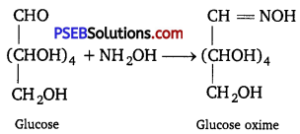
Question 4.
What are anomers?
Answer:
A pair of stereoisomers such as α-D-(+) glucose and β-D-(+) glucose which differ in configuration only around C1 are called anomers.
![]()
Question 5.
What type of linkage is present in proteins?
Answer:

Question 6.
What are Vitamins?
Answer:
Vitamins are generally regarded as organic compounds required in the diet in small amounts to perform specific biological functions for normal maintenance of optimum growth and health of the organism.
Question 7.
Why must vitamin C be supplied regularly in diet? [NCERT Exemplar]
Answer:
Vitamin C is water-soluble hence, they are regularly excreted in urine and can not be stored in our body, so, they are supplied regularly in diet.
Question 8.
Of the two bases named below, which one is present in RNA and which one is present in DNA? Thymine, Uracil.
Answer:
- Thymine is present in DNA.
- Uracil is present in RNA.
Question 9.
The activation energy for the acid-catalyzed hydrolysis of sucrose is 6.22 kJ mol-1, while the activation energy is only 2.15 kJ mol-1 when hydrolysis is catalyzed by the enzyme sucrase. Explain. [NCERT Exemplar]
Answer:
Enzymes, the biocatalysts reduce the magnitude of activation energy by providing alternative paths. In the hydrolysis of sucrose, the enzyme sucrase reduces the activation energy from 6.22 kJ mol-1 to 2.15 kJ mol-1.
Question 10.
Name the bases present in RNA. Which one of these is not present in DNA?
Answer:
The bases present in RNA are Adenine (A), Guanine (G), Cytosine (C) and Uracil (U). Uracil is not present in DNA.
![]()
Short answer type questions
Question 1.
What is essentially the difference between α-glucose and β-glucose? What is meany by pyranose structure of glucose?
Answer:
α -Glucose and β-Glucose differ only in the configuration of hydroxy group at C1 and are called anomers and the C1 carbon is called anomeric carbon. The six-membered cyclic structure of glucose is called pyranose (α-or β), in analogy with pyran. The cyclic structure of glucose is more correctly represented by Haworth structure as given below:

Question 2.
Describe the term D- and L-configuration used for amino acids with examples. [NCERT Exemplar]
Answer:
All naturally occurring a-amino acids (except glycine) are optically active due to the presence of chiral carbon atom. These have either D- or L-configuration. D-form means that the amino (-NH2) group is present towards the right-hand side. L-form shows the presence of -NH2 group on the left-hand side.
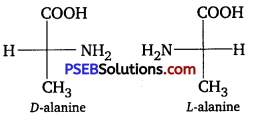
Question 3.
Aldopentoses named as ribose and 2-deoxyribose are found in nucleic acids. What is their relative configuration? [NCERT Exemplar]
Answer:
In case of cyclic structure of saccharide, if -OH group present at second last carbon is present at bottom side, then it is considered as D configuration (as shown above).
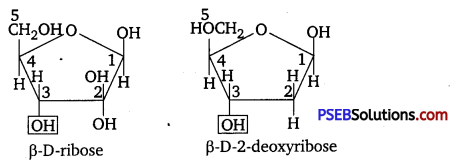
Question 4.
How do enzymes help a substrate to be attacked by the reagent effectively? [NCERT Exemplar]
Answer:
At the surface of enzyme, active sites are present. These active sites of enzymes hold the substrate molecule in a suitable position so that it can be attacked by the reagent effectively. This reduces the magnitude of activation energy.
Enzymes contains cavities of characteristics shape and possessing active groups known as active centre on the surface. The molecules of the reactant (substrate) having complementary shape, fit into these cavities. On account of these active groups, an activated complex is formed which then decomposes to yield the products.
![]()
Question 5.
Amino acids can be classified as α-, β-, γ-, δ- and so on depending upon the relative position of amino group with respect to carboxyl group. Which type of amino acids form polypeptide chain in proteins? [NCERT Exemplar]
Answer:
α-amino acid forms a polypeptide chain by elimination of water molecules.
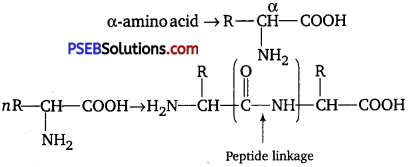
Question 6.
(i) Winch vitamin deficiency causes rickets?
(ii) Name the base that is found in nucleotide of RNA only.
(iii) Glucose on reaction with acetic acid gives glucose Penta acetate. What does it suggest about the structure of glucose?
Answer:
(i) Vitamin D
(ii) Uracil
(iii) 5-OH groups are present in glucose.
Long answer type questions
Question 1.
Which moieties of nucleosides are involved in the formation of phosphodiester linkages present in dinucleotides? What does the word diester in the name of linkage indicate? Which acid is involved in the formation of this linkage?
Answer:
(i) 5′ and 3′ carbon atoms of pentose sugar.
(ii) Most probably the resemblance of with 2 esters (-COO)2 groups joined together.

(iii) Phosphoric acid (H3PO4).
Nucleosides are joined together by phosphodiester linkage between 5′ and 3′ carbon atoms of pentose sugar and a dinucleotide with phosphoric acid (CH3PO4) is formed.
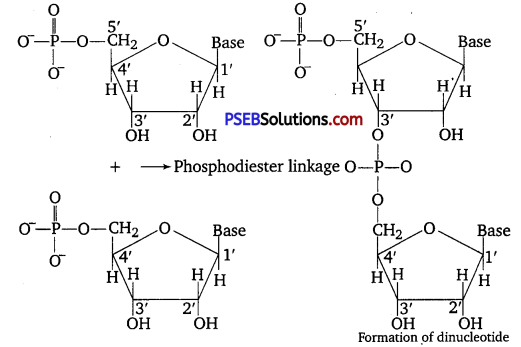
Question 2.
Write the structures of fragments produced on complete hydrolysis of DNA. How are they linked in DNA molecules? Draw a diagram to show pairing of nucleotide bases in double helix of DNA. [NCERT Exemplar]
Answer:
On complete hydrolysis of DNA, following fragments are formed-pentose sugar (β-D-2-deoxyribose), phosphoric acid (H3PO4) and bases (nitrogen-containing heterocyclic compounds).
Structures
(i) Sugar
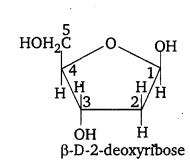
(ii) Phosphoric acid
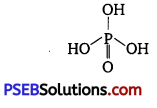
(iii) Nitrogen bases: DNA contains four bases.
Adenine (A), Guanine (G), Cytosine (C), and Thymine (T).
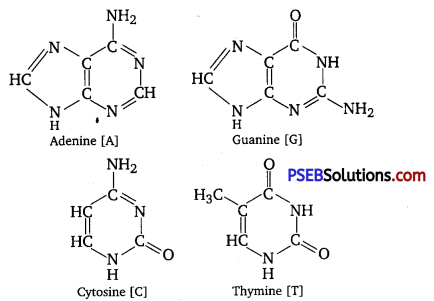
A unit formed by the attachment of a base to 1′-position of sugar is called nucleoside. When nucleoside links to phosphoric acid at 5′-position of sugar moiety, a nucleotide is formed. Nucleotides are joined together by phosphodiester linkage between 5′ and 3′ carbon atoms of the pentose sugar. In DNA two nucleic acid chains are wound about each other and held together by hydrogen bonds between pairs of bases.
![]()
The two strands are complementary to each other because hydrogen bonds are formed between specific pairs of base adenine form hydrogen bonds with thymine whereas cytosine forms hydrogen bonds with guanine.
